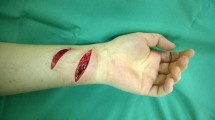Abstract
Background and objectives
Severe shoulder dystocia (SD) is associated with neonatal brachial plexus injuries and skeletal fractures, with the former being the commonest cause for litigation related to birth trauma. The aim of this case-control study was to evaluate risk factors for birth injuries in cases presenting with SD.
Methods
Between January 2000 and December 2006, 22 babies who sustained brachial nerve paralysis or skeletal fractures following severe SD and requiring admission to Special Care Baby Unit (SCBU) were identified. The control group (n = 22) comprised the next infant delivered who was deemed to have SD but did not suffer significant birth injuries. Antenatal, labour and postnatal data were collected and compared between the two groups.
Results
The study and control groups had similar median maternal age (28 vs. 26.5 years), gestational age at delivery (40 vs. 40 weeks) and estimated blood loss (300 vs. 225 ml) (both P > 0.05, Mann–Whitney test). Median 1 min Apgar scores (5.5 vs. 7), maternal BMI (31.34 vs. 27.19 kg/m2) and duration of second stages (53.8 vs. 49.2 min) were also statistically similar in both groups (P > 0.05). However, compared to controls, brachial nerve injuries and skeletal fractures were more likely to occur in mothers with gestational diabetes (5/22 vs. 1/22) or who had previous big babies (4/22 vs. 1/22) (both P < 0.05, Fisher’s exact test). Babies who had birth injuries were also more likely to have greater median birth weights (4.3 vs. 3.8 kg) and postnatal anthropometric measurements such as head circumference (35 vs. 34 cm) and ponderal indices (81.9 vs. 74.3 kg/m3) compared to controls.
Conclusion
In babies with SD, brachial nerve injuries and skeletal fractures are more likely to occur in those with greater birthweights but also larger length to weight ratios. In these babies, assessment of abdominal circumference and biacromial length by magnetic resonance imaging (MRI) may help predict the likelihood of severe SD, especially in mothers with identifiable risk factors. However, further research in larger controlled trials are still needed to determine their predictive value.



Similar content being viewed by others
References
Acker D, Sachs B, Friedman E (1985) Risk factors for shoulder dystocia. Obstet Gynecol 66:762–768
Mehta SH, Bujold E, Blackwell SC, Sorokin Y, Sokol RJ (2004) Is abnormal labour associated with shoulder dystocia in nulliparous women? Am J Obstet Gynecol 190(6):1604–1607, discussion 1607–1609
Christofferson M, Rydhstroem H (2002) Shoulder dystocia and brachial plexus injury: a population-based study. Gynecol Obstet Invest 53(1):42–47
Mehta SH, Blackwell SC, Bujold E, Sokol RJ (2006) What factors are associated with neonatal injury following shoulder dystocia? J Perinatol 26(2):85–88
Cederqren MI (2004) Maternal morbid obesity and the risk of adverse pregnancy outcome. Obstet Gynecol 103(2):219–224
Jazayeri A, Heffron JA, Phillips R, Spellacy W (1999) Macrosomia prediction using ultrasound foetal abdominal circumference of 35 cm or more. Obstet Gynecol 93:523–526
Olugbile A, Mascarenhas L (2000) Review of Shoulder dystocia at the Birmingham Women’s Hospital. J Obstet Gynaecol 20(3):267–270
Royal College of Obstetricians and Gynaecologists Guideline 42. Shoulder dystocia. December 2005
Gherman RIB, Ouzounian JG, Satin AJ, Goodwin TM, Phelan JP (2003) A comparison of shoulder dystocia-associated transient and permanent brachial plexus palsies. Obstet Gynecol 102(3):544–548
Baskett TF, Allen AC (1995) Perinatal implications of shoulder dystocia. Obstet Gynecol 177:1462–1464
Rouse DJ, Owen J, Goldenberg RL, Cliver SP (1996) The effectiveness and costs of elective Caesarean delivery for foetal macrosomia diagnosed by ultrasound. JAMA 276(18):1480–1486
Ott WJ, Doyle S (1984) Ultrasound diagnosis of altered fetal growth by use of normal ultrasound fetal weight curve. Obstet Gynecol 63:201–208
Sandmire HF, DeMott RK (2002) Erb’s Palsy without shoulder dystocia. Int J Gynecol Obstet 78:253–256
Gherman RB, Goodwin TM, Ouzounian JG, Miller DA, Paul RH (1997) Brachial plexus palsy associated with cesarean section: an in utero injury? Am J Obstet Gynecol 177:1162–1164
Lehingue Y, Remontet L, Munoz F, Marnelle N (1998) Birth ponderal index and body mass index reference curves in a large population. Am J Human Biol 10(3):327–340
Christoffersson M, Kannisto P, Rydhstroem H, Stale H, Walles B (2003) Shoulder dystocia and brachial plexus injury: a case-control study. Acta Scand Gynecol Obstet 82(2):147–151
O’Leary JA (1992) Shoulder dystocia and birth injury. Prevention and treatment, 1st edn. McGraw-Hill Inc., New York, pp 1–7
Kitzmiller JL, Mall JC, Gin GD, Hendricks SK, Newman RB, Scheerer L (1987) Measurement of foetal shoulder width with computed tomography in diabetic women. Obstet Gynecol 70(6):941–945
Kastler B, Gangi A, Mathelin C, Germain P, Arhan JM, Treisser A, Dietemann JL, Wackenheim A (1993) Foetal shoulder measurements with MRI. J Comput Assist Tomogr 17(5):777–780
O’Leary JA (1992) Shoulder dystocia and birth injury. Prevention and treatment, 1st edn. McGraw-Hill Inc., New York, pp 25–40
Zuspan F, Quilligan E (1988) Douglas-Stromme Operative Obstetrics, 5th edn. Norwall, Appleton and Lange
Crofts JF, Bartlett C, Ellis D, Hunt LP, Fox R, Draycott T (2006) Training for shoulder dystocia: a trial of simulation using low-fidelity and high-fidelity mannequins. Obstet Gynecol 108:1477–1485
Acknowledgments
We would like to thank Mr A Fakokunde for his support during the initial part of the study. JM designed the methodology, collected and then analysed the data; in addition he performed the literature search and co-wrote the manuscript. RB and LC did additional literature searches and co-wrote the manuscript. VW helped with the methodology and co-wrote the manuscript. WY initiated the study, designed the methodology and co-wrote the manuscript.
Conflict of interest
The authors declare that they have no competing interests.
Author information
Authors and Affiliations
Corresponding author
Rights and permissions
About this article
Cite this article
Melendez, J., Bhatia, R., Callis, L. et al. Severe shoulder dystocia leading to neonatal injury: a case control study. Arch Gynecol Obstet 279, 47–51 (2009). https://doi.org/10.1007/s00404-008-0668-6
Received:
Accepted:
Published:
Issue Date:
DOI: https://doi.org/10.1007/s00404-008-0668-6




